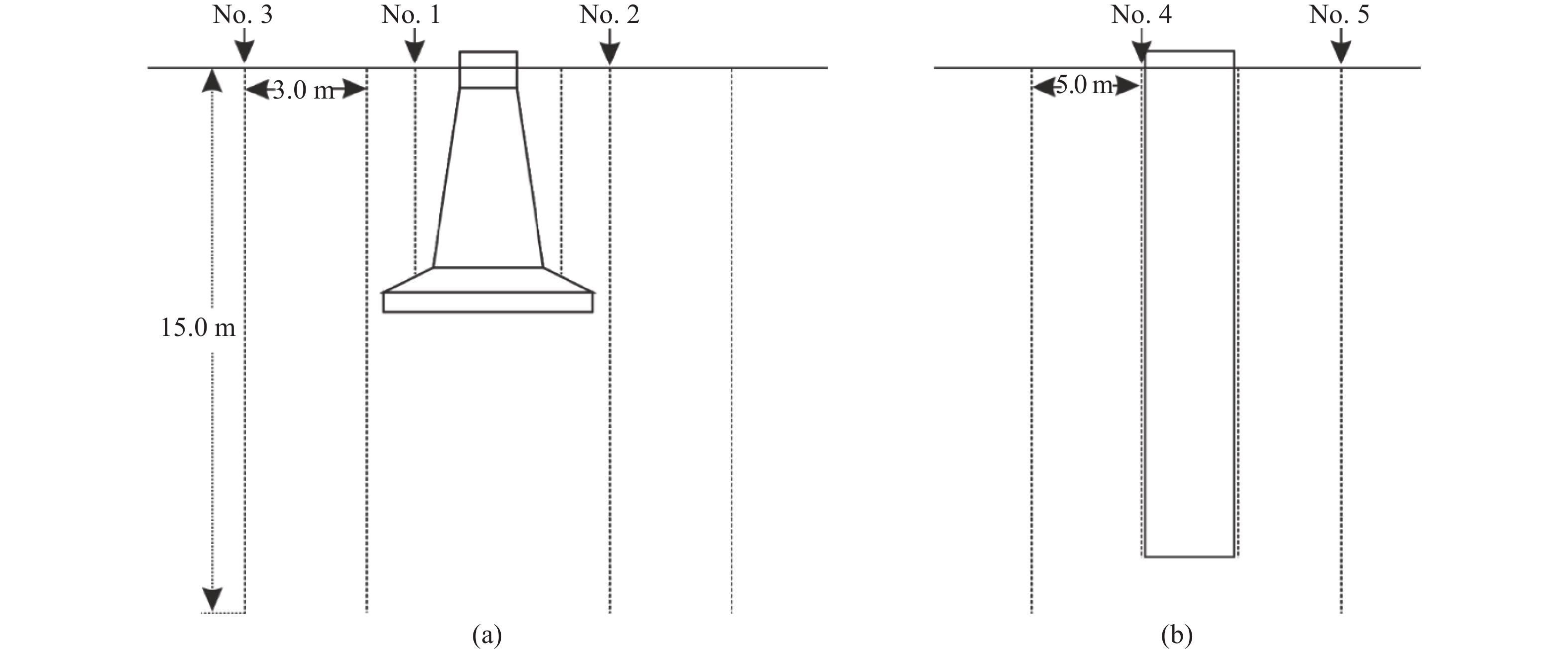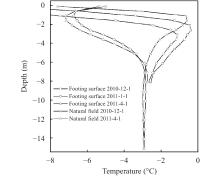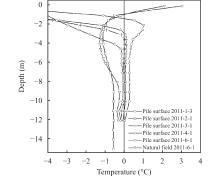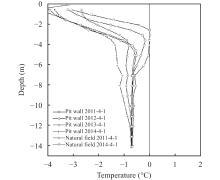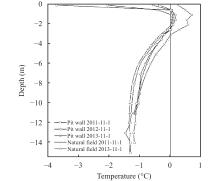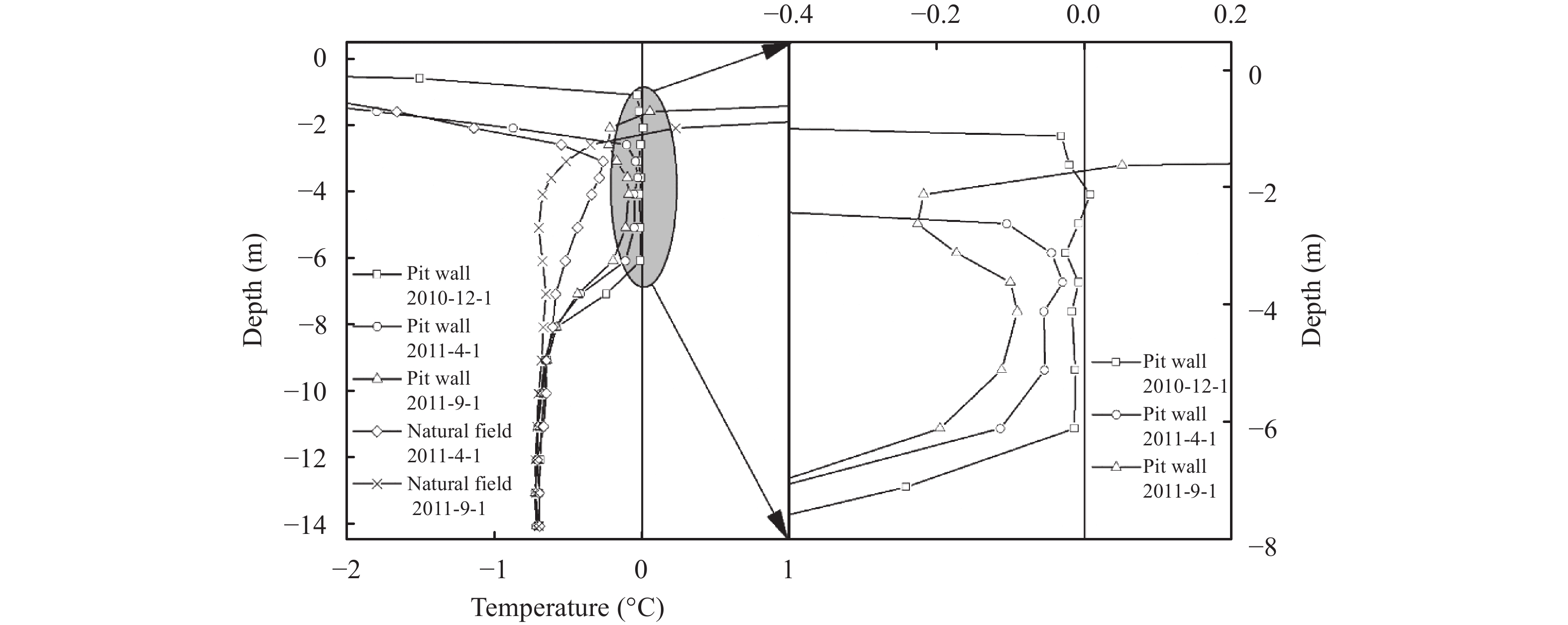Sciences in Cold and Arid Regions ›› 2019, Vol. 11 ›› Issue (1): 13–20.doi: 10.3724/SP.J.1226.2019.00013
The changing process and trend of ground temperature around tower foundations of Qinghai-Tibet Power Transmission line
YanLi Xie1,QiHao Yu2,*( ),YanHui You2,ZhongQiu Zhang1,TingTao Gou1
),YanHui You2,ZhongQiu Zhang1,TingTao Gou1
- 1 State Grid Qinghai Electric Power Research Institute, Xining, Qinghai 810008, China
2 State Key Laboratory of Frozen Soil Engineering, Northwest Institute of Eco-environment and Resources, Chinese Academy of Sciences, Lanzhou, Gansu 730000, China
| 1 |
Chen ZY, Li GY, Yu QH, et al. Study of the thermal stability of cast-in-place pile foundations of the Qinghai-Tibet DC Transmission Project in permafrost regions. Journal of Glaciology and Geocryology 2013; 35: 5 1209- 1218.
doi: 10.7522/j.issn.1000-0240.2013.0136 |
| 2 |
Cheng GD, Zhao L The problems associated with permafrost in the development of the Qinghai-Xizang Plateau. Quaternary Sciences 2000; 20: 6 521- 531.
doi: 10.3321/j.issn:1001-7410.2000.06.004 |
| 3 | Cui W, Wu QB, Liu YZ The thermal effect of a thermokarst lake on permafrost. Journal of Glaciology and Geocryology 2010; 32: 4 755- 760. |
| 4 |
Duan X, Naterer GF Heat conduction with seasonal freezing and thawing in an active layer near a tower foundation. International Journal of Heat and Mass Transfer 2009; 52: 7–8 2068- 2078.
doi: 10.1016/j.ijheatmasstransfer.2008.11.004 |
| 5 |
Gu W, Yu QH, Qian J, et al. Qinghai-Tibet Expressway experimental research. Sciences in Cold and Arid Regions 2010; 2: 5 396- 404.
doi: 10.3724/SP.J.1226.2010.00396 |
| 6 |
Guo L, Yu QH, You YH, et al. Cooling effects of thermosyphons in tower foundation soils in permafrost regions along the Qinghai–Tibet Power Transmission Line from Golmud, Qinghai Province to Lhasa, Tibet Autonomous Region, China. Cold Regions Science and Technology 2016a; 121: 196- 204.
doi: 10.1016/j.coldregions.2015.07.011 |
| 7 |
Guo L, Yu QH, You YH, et al. Evaluation on the influences of lakes on the thermal regimes of nearby tower foundations along the Qinghai-Tibet Power Transmission Line. Applied Thermal Engineering 2016b; 102: 829- 840.
doi: 10.1016/j.applthermaleng.2016.03.135 |
| 8 | Hao ZC, Jiang WJ, Ju Q, et al. The features of climate changes in the Five River source regions of the Tibetan Plateau. Journal of Glaciology and Geocryology 2010; 32: 6 1130- 1135. |
| 9 |
Jiang HP, Liu ZR ±500 kV direct current transmission line ground and foundation design in frozen earth area. Inner Mongolia Electric Power 2006; 24: 4 1- 4.
doi: 10.3969/j.issn.1008-6218.2006.04.001 |
| 10 |
Li GY, Yu QH, Ma W, et al. Impacts of permafrost mean annual ground temperature and ice content on thermal regime of pile foundation of Qinghai-Tibet power transmission line. Advanced Materials Research 2013; 610–613: 2832- 2839.
doi: 10.4028/www.scientific.net/AMR.610-613.2832 |
| 11 |
Li GY, Yu QH, Ma W, et al. Freeze–thaw properties and long-term thermal stability of the unprotected tower foundation soils in permafrost regions along the Qinghai–Tibet Power Transmission Line. Cold Regions Science and Technology 2016; 121: 258- 274.
doi: 10.1016/j.coldregions.2015.05.004 |
| 12 | Li MY, Wu QB, Liu YZ Monitoring the soil heat-moisture processes within an embankment in Qinghai-Tibet Railway. Journal of Glaciology and Geocryology 2011; 33: 3 546- 551. |
| 13 | Liu SW, Zhang JM Review on physic-mechanical properties of warm frozen soil. Journal of Glaciology and Geocryology 2012; 34: 1 120- 129. |
| 14 |
Liu SW, Zhang JM, Zhang H, et al. Research on long-term creep test of permafrost on Qinghai-Tibet Plateau. Chinese Journal of Rock Mechanics and Engineering 2012; 31: S1 3245- 3253.
doi: 10.3969/j.issn.1000-6915.2012.z1.088 |
| 15 |
Lyazgin A, Lyashenko VS, Ostroborodov SV, et al. Experience in the prevention of frost heave of pile foundations of transmission towers under northern conditions. Power Technology and Engineering 2004; 38: 2 124- 126.
doi: 10.1023/B:HYCO.0000036365.64731.4c |
| 16 |
Ma W, Wu ZW, Zhang LX, et al. Analyses of process on the strength decrease in frozen soils under high confining pressures. Cold Regions Science and Technology 1999; 29: 1 1- 7.
doi: 10.1016/S0165-232X(98)00020-2 |
| 17 |
Wang SH, Qi JL, Yao XL Stress relaxation characteristics of warm frozen clay under triaxial conditions. Cold Regions Science and Technology 2011; 69: 1 112- 117.
doi: 10.1016/j.coldregions.2011.06.015 |
| 18 | Yang CS, Cheng GD Probabilistic prediction of the impacts of climate change on permafrost stability along the Qinghai-Tibet Railway (I): Active layer thickness and ground temperature. Journal of Glaciology and Geocryology 2011; 33: 3 461- 468. |
| 19 |
You YH, Yang MB, Yu QH, et al. Investigation of an icing near a tower foundation along the Qinghai–Tibet Power Transmission Line. Cold Regions Science and Technology 2016; 121: 250- 257.
doi: 10.1016/j.coldregions.2015.05.005 |
| 20 |
Yu QH, Pan XC, Cheng GD, et al. Heat transfer process of roadway embankments with different type and width of road surface in permafrost regions. Progress in Natural Science 2007; 17: 3 314- 319.
doi: 10.1080/10020070612331343263 |
| 21 |
Yu QH, Liu HJ, Qian J, et al. Research on frozen engineering of Qinghai-Tibet 500 kV DC power transmission line. Chinese Journal of Engineering Geophysics 2009; 6: 6 806- 812.
doi: 10.3969/j.issn.1672-7940.2009.06.029 |
| 22 | Yu QH, Fan K, Qian J, et al. Key issues of highway construction in permafrost regions in China. Scientua Sinica Technologica 2014; 44: 4 425- 432. |
| 23 |
Yu Q, Ji YJ, Zhang ZQ, et al. Design and research of high voltage transmission lines on the Qinghai–Tibet Plateau—a special issue on the permafrost power lines. Cold Regions Science and Technology 2016; 121: 179- 186.
doi: 10.1016/j.coldregions.2015.05.003 |
| 24 |
Yu RF Research on frozen foundation around pole of transmission line. Jilin Electric Power 2002; 2 9- 12.
doi: 10.3969/j.issn.1009-5306.2002.02.003 |
| 25 |
Zhao XD, Zhou GQ Experimental study on the creep behavior of frozen clay with thermal gradient. Cold Regions Science and Technology 2013; 86: 127- 132.
doi: 10.1016/j.coldregions.2012.10.012 |
| No related articles found! |




